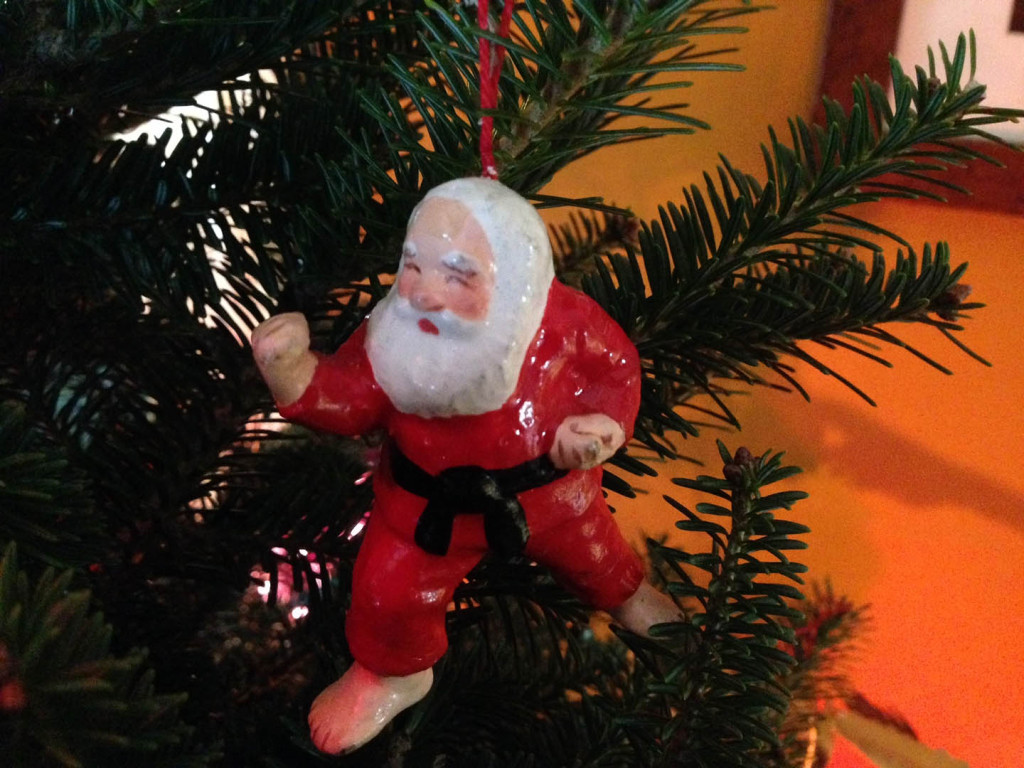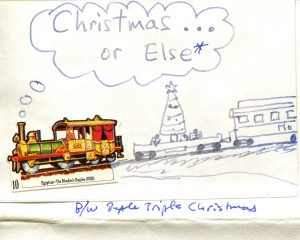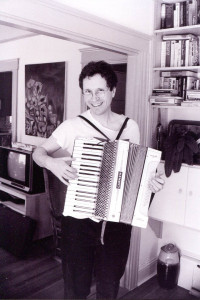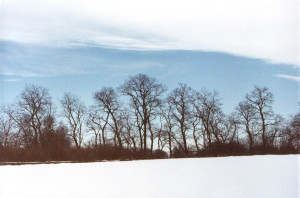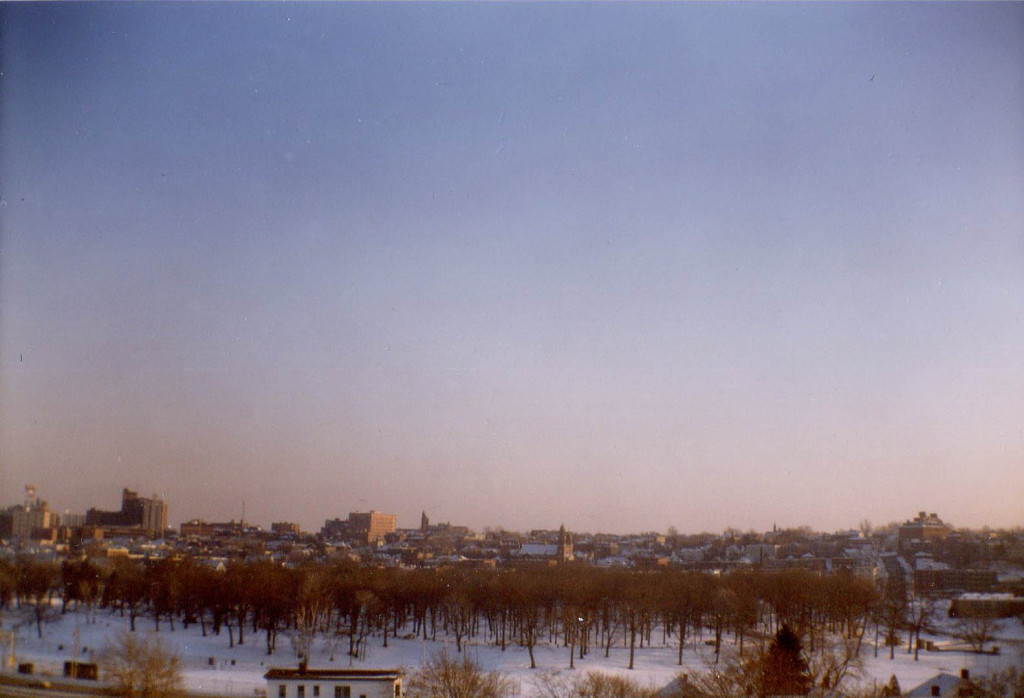“Merry Christmas!” He Bellowed
Hurry, Santa, don’t make us wait! Let’s go straight to swinging Christmas sounds!
In 1974, as described in a previous Note From the Basement, I started producing so-called Christmas Greeting Tapes as substitutes for holiday cards.
These combined music with “funny” bits (sometimes yes, sometimes not so much) and a few minutes of cringeworthy personal messaging. I recorded the greetings in my parents’ basement on the Sony reel-to-reel and stayed up too late, usually just a day or two before the holiday, dubbing them onto cassettes for friends and family.
The 1974 greeting pretty much consisted of “Jingle Bells,” recorded with Alvin and the Chipmunks-style singing: the vocals enunciated precisely and recorded at a slow speed. Playback at normal speed produced that wacky high-pitched sound we all love so well. It was a technique I used again on the 1975 and 1976 greetings (sample follows).
How can an ironic spirit prevail against the holiday-industrial complex? What does any of this — the birth of Christ, walking in a winter wonderland, chestnuts roasting on an open fire — have to do with the lives that we’re living now? Willie Nelson’s “Pretty Paper” strikes me as the most pertinent of the bunch these days.
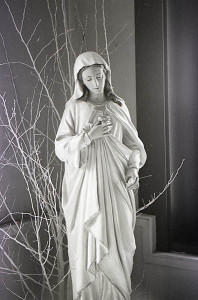
A statuette in The Cathedral of the Immaculate Conception, Portland, Maine, 1989. Digital scan from black & white negative / Hubley Archives.
Well, back in those days, I was looking for a way to make it work. I was still trying to master (and reconcile) the influences of Curley Howard, Raymond Chandler, Gram Parsons, Lou Reed and Bing Crosby. For the Christmas Greeting Tapes, I continued to mine mid-century Christmas pop into the 1980s, from “The Christmas Song” to “Silver Bells,” from “Rockin’ Around the Christmas Tree” to “Santa Claus is Back in Town.” I threw in a few originals and familiar traditional numbers. (The otherwise lackluster 1985 tape featured a standout “Twelve Days of Christmas” performed by as many friends and family members as I could muster up.)
Clues to a new direction surfaced around 1980 when, in a record shop on Portland’s Fore Street, I discovered Nowell Sing We Clear. Recorded by four Vermonters — U.K. natives John Roberts and Tony Barrand and American accompanists Fred Breunig and Steve Woodruff — this collection of centuries-old British carols showed me the door to a realm of much less familiar traditional Old World holiday music.
What eventually got me through the door, a few years later, was the accordion.
Let’s go back still further, to the 1960s. There was a funny-looking kid whom I scorned in middle school not only on account of his visage, but also his earnest and well-intended squareness. He was always friendly to me, the bastard. Worst of all, despite all these disqualifications, he had a lock on a girl I wanted.
The cherry on this sundae of hideous offenses was that he played the accordion. (Offering “Lady of Spain,” no less, at a Mahoney Middle School talent show, or so I recall).
I have realized only now that this guy, with the blemishes on his mug and the girl of my dreams (of the month) on his arm, actually had something going for him. We call it talent.
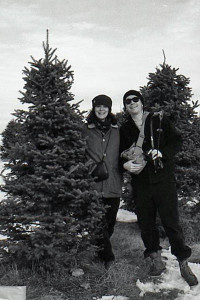
Posing with our prey at Merry Christmas Trees, Windham, in 1994. Photo by self-timer / scanned from black and white negative. Hubley Archives.
I have thought of him only now as I realize that he got more accordion playing into his fingers in 10 or 12 years of life than I did during the 24 years I was active with the accordion, from 1986 to 2010. I think I peaked on the squeezebox from 1992 through 1996, when, with my bands the Cowlix and the Boarders, I was able to get through the accordion material without shame, but also without glory.
I couldn’t have pictured myself wearing the bellows in the 1960s, when I was scorning my “Lady of Spain”-squeezing schoolmate. My conversion from hater to lover of accordion began 10 years later, in the late 1970s, when friend and bandmate Ken Reynolds introduced me to the great English musician Richard Thompson.
I instantly became a rabid fan and bought as much of Thompson as I could. He incorporated a lot of British folk influences into his music and there was plenty of accordion, mostly button box played by the excellent John Kirkpatrick.
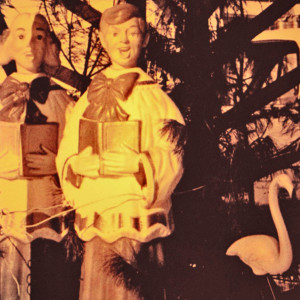
Detail from a roadside Christmas display, 1988. Digitally irradiated scan from black and white negative. Hubley Archives.
In a kind of parallel with Nowell Sing We Clear and Christmas music, what brought me around to accordion was hearing it as a folk instrument instead of a pop schmaltz generator. I liked the simpler scales, the rougher sound and the snappy pulmonary rhythms of the folk squeezebox.
Moreover, as my ears were opening to the accordion, they were also flapping in the prevailing breezes of the 1980s world music craze. I didn’t so much join the throngs congregating around African and Latin American styles, but instead gravitated to sounds of Canada, Europe and especially around the Mediterranean.
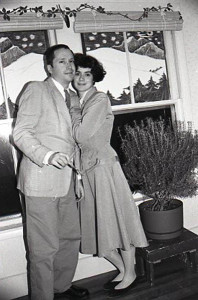
Gretchen and I dolled up and awaiting guests for the 1988 holiday party. Note the alpine window inserts that G. made. Photo by self-timer / scanned from black and white negative. Hubley Archives.
This wealth of music, along with the classical stuff I was trying to absorb for concert reviews, effected a seismic shift in perspective. If you get a well-syncopated two-beat into your brain, for instance, or the 7/8 or 11/8 or other odd rhythms of Balkan music, the square 4/4 of rock music suddenly looms a lot smaller. Ditto with the melodies of much mainstream pop-rock. (“Forty flavors of milk” was the term I used in a Maine Sunday Telegram review.)
So in 1986, a year when I was not in a band, I bought a cheap piano accordion and a bunch of Palmer-Hughes instruction books and dug in. (This necessitated learning to read music as well as to manipulate the instrument. Palmer-Hughes must have been OK pedagogically, since I did learn to translate musical notation and to play accordion after a fashion, but the song choices were strictly from Schmaltzville. “Vegetables on Parade,” anyone?)
1986 was also the first year since 1974 when I didn’t produce a Christmas Greeting Tape, in light of the uninspired 1985 edition. But 1987 brought the first in a new wave of Christmas Greeting Tapes, dedicated primarily to traditional European Christmas music. (Some selections from those tapes follow.)
Unlike the funny-looking kid from Mahoney, I never really got it right with the accordion. Nowadays the Excelsior 48-bass just sits there in the cellar looking reproachful as I neglect it in favor of mandolin and guitar.
But if I never had a gift for the accordion, the world of music that I discovered through the squeezebox was certainly a gift for me.
Selections from the 1987, 1988, 1990 and 1995 Christmas Greeting Tapes. All selections except “Scary Christmas Polka” are traditional. “Scary Christmas Polka” copyright © 2010 by Douglas L. Hubley. All rights reserved.
- Czech Christmas Medley — Recorded for “Duple Triple Christmas” in 1990, this medley consists of the traditional Czech carols “Hajej, nynjej,” a lullaby; and “Pujdem spolu do Betléma (“Come to Bethlehem”).
- Scary Christmas Polka (Hubley) The one original song in this set, and the only one performed with a band. I wrote “Scary Christmas Polka” in 1990, during a period of unemployment and financial worry, and released it as a solo performance on that year’s Christmas Greeting Tape. In 1995, the Boarders learned it for a December gig and are performing it here in a rehearsal recording. Gretchen Schaefer plays bass and Jonathan Nichols-Pethick, drums.
- C’est la Noël — A traditional song from the south of France that I recorded for the 1990 tape. I remember standing at the mic in the dark music room cursing each mistake.
- European Christmas Medley — From “Christmas, Or Else!” (1987), my first Christmas Greeting Tape featuring accordion. The songs: “God Rest Ye Merry, Gentlemen” (English) / “Good Christian Men, Rejoice” (German and English) / “Lulajze Jezuniu” (Polish) / “Lippai” (Tyrolean) / “Bring a Torch, Jeanette, Isabella” (French).
- No Room at the Inn — (Trad., arranged and with new lyrics by Doug Hubley) From the 1988 tape, “It Came Upon a Midnight Lira, or Merry Christmas! He Bellowed” (Lira was the brand of my accordion). A song cobbled together in 1928 from lyrics and melodies of diverse old English origins. I took it a bit further with a strong rhythm and a new verse of still-pertinent import.
- Masters in This Hall — 1988. An old French melody.
- Susanni — A 16th-century German melody with 17th-century lyrics. I like the image of all the musicians showing up. Backing vocal and guitar by Gretchen Schaefer. From the 1990 tape.
Text copyright © 2013 by Douglas L. Hubley. All rights reserved.
